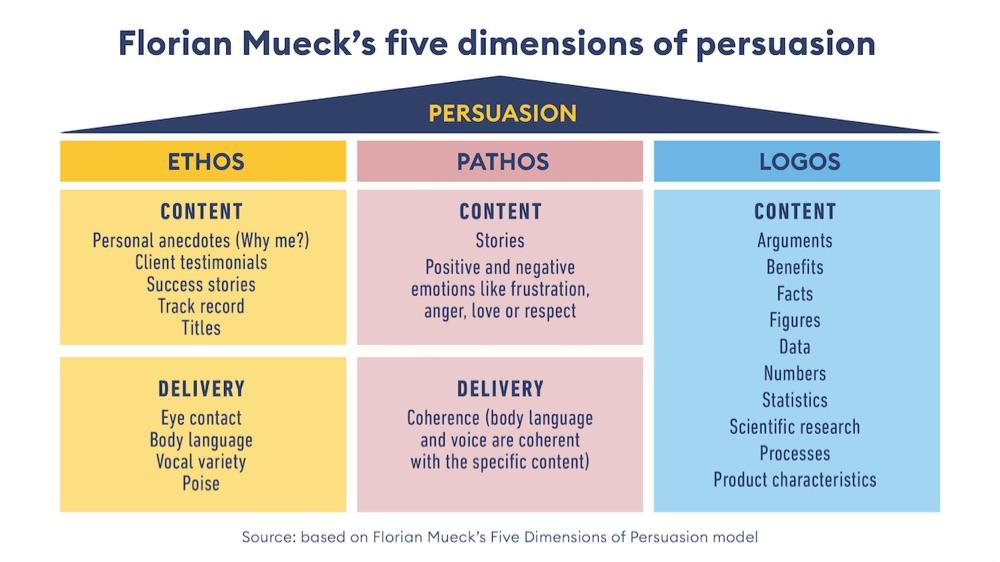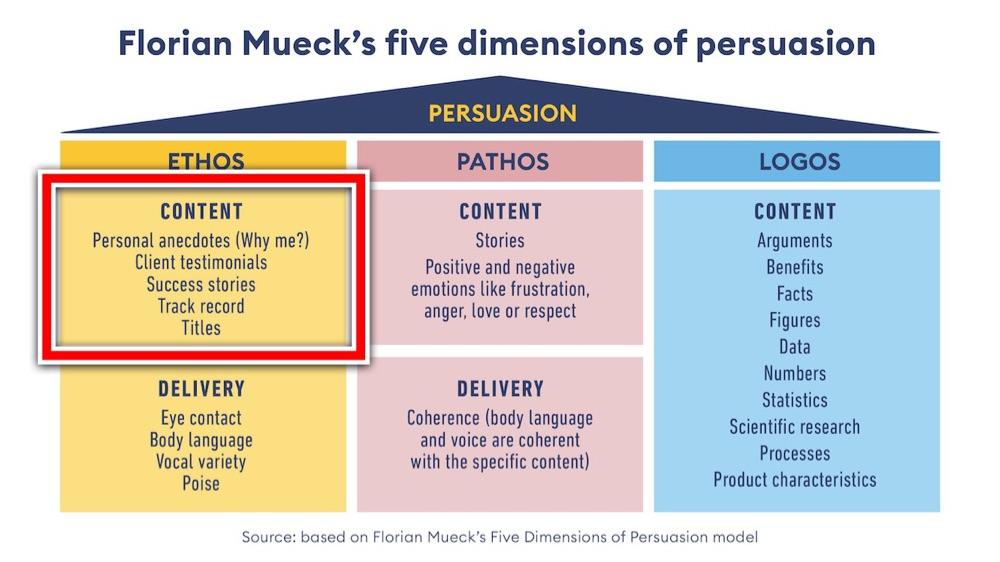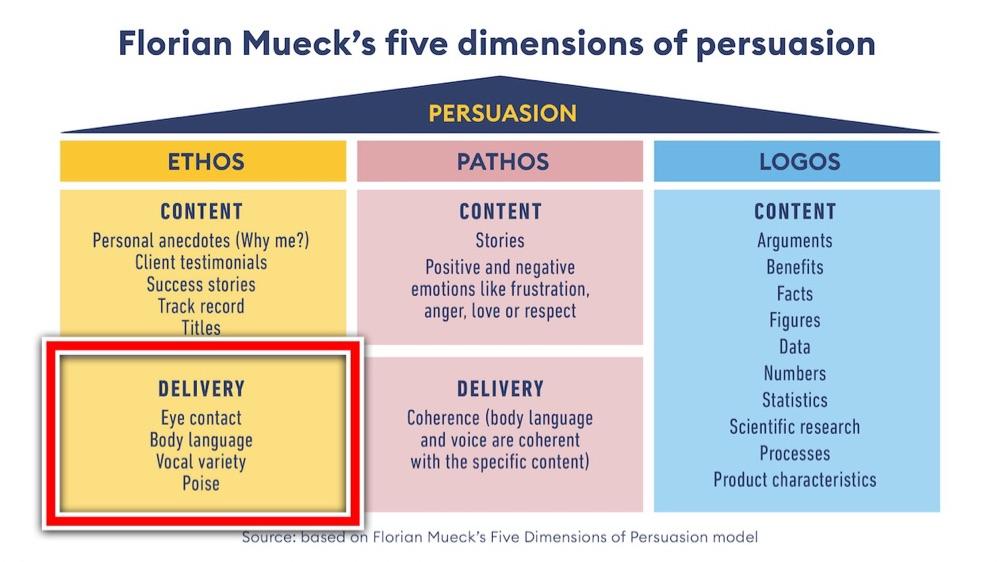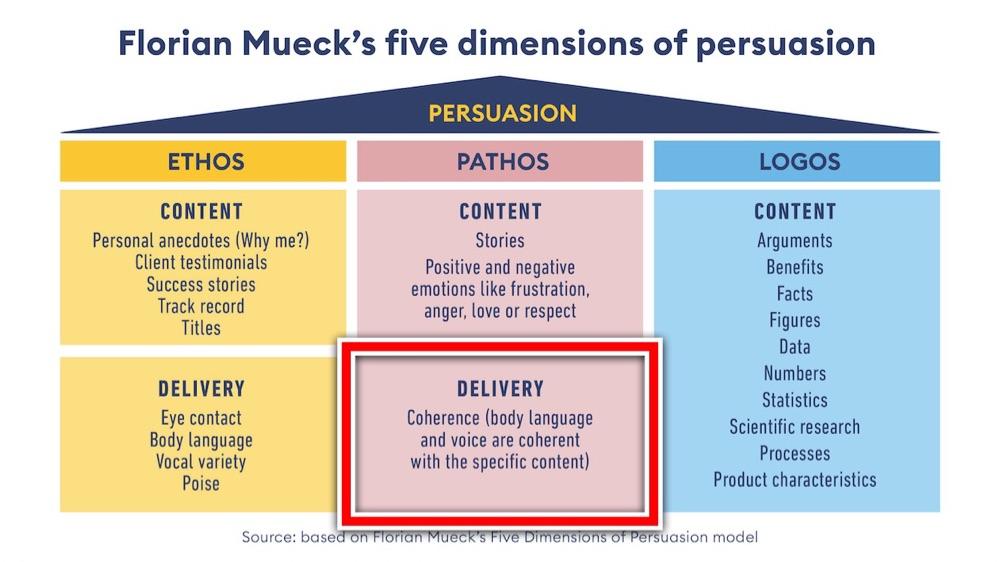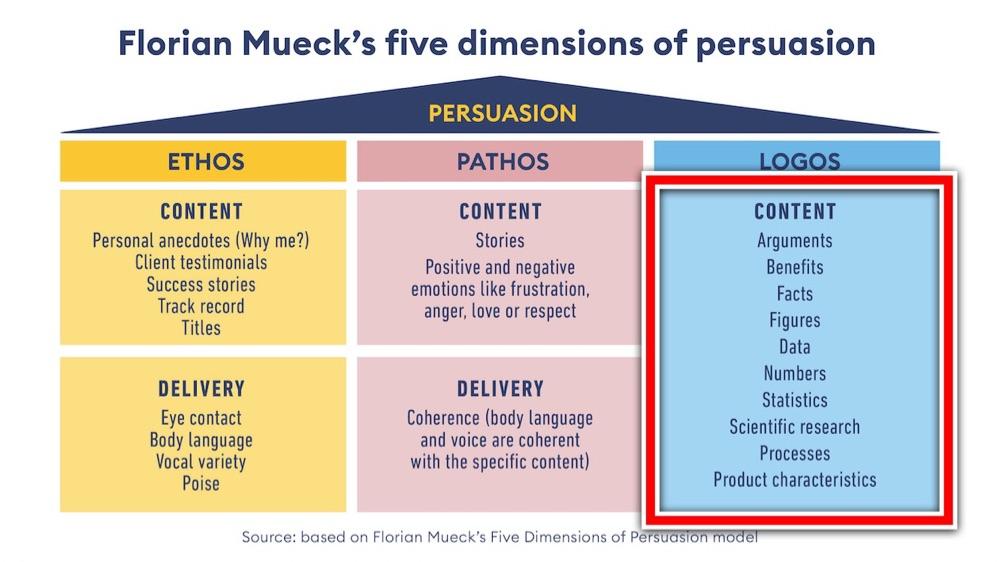Aristotle’s Modes Of Persuasion (Or Modes Of Appeal)
Curated from: changeboard.com
Ideas, facts & insights covering these topics:
34 ideas
·12.2K reads
47
5
Explore the World's Best Ideas
Join today and uncover 100+ curated journeys from 50+ topics. Unlock access to our mobile app with extensive features.
“Back Again? Dear, Oh Dear!” (Two Can Say That)
There’s really no such thing as the all-powerful, charismatic presenter who just turns up on stage and does his or her stuff. We shouldn’t be fooled by how easy some people can make it look. No matter how competent we are at presenting, there is always room for improvement. And for those of us who are not natural presenters, it’s a skill we can learn. Which is just as well, as presenting well can be integral to individual and personal success, especially in business.
155
1.87K reads
We Present To Persuade
The power of a well-delivered, well-structured and convincing presentation is not new. Understanding and deploying the components of persuasive speaking have a long history. And that’s what we’re really looking to do when we present: persuade. Presenting well enables us to get our messages across clearly and confidently to different stakeholders, reducing miscommunication. Presenting brilliantly allows us to persuade and influence, motivate, galvanise and lead. For that, we need to be aware of the factors that make for a powerful presentation, and how we can use them to best effect.
155
1.2K reads
Aristotle’s 3 Modes Of Persuasion
Aristotle’s three “modes of persuasion, furnished by the spoken word” – ethos, pathos and logos – offer a practical framework that can set us on the path to presenting success.
- Ethos depends on the personal character of the speaker – what we bring through our personality, experience and credentials.
- Pathos is about putting the audience into a certain frame of mind – how we can make an emotional connection with them.
- Logos is based on the proof, or apparent proof, provided “by the words of the speech itself” – what we want to say and how we’ll structure and present it; our reasoning.
175
1.11K reads
Florian Mueck’s 5 Dimensions Of Persuasion
So far, so good. But when it comes to creating and delivering a presentation ourselves, it’s useful to think about how these classic modes of persuasion might be used in practice.
Author and consultant Florian Mueck suggests that we look at the three modes in a slightly different way to help us make sense of what they mean. For Mueck, Aristotle’s three modes break down into five dimensions, with logos being exclusively content-driven, but ethos and pathos having two dimensions: a content and a delivery side.
That means that we need to be aware not just of what we say but also of how we say it.
165
897 reads
Mode 1: Ethos - The Appeal To Authority Or Credibility
Under Aristotelian thinking, ethos is the most powerful element of communication. While logos (logic or knowledge) is important – people will believe in us only if they understand what we are trying to say – and pathos (passion) is persuasive – if people can connect and engage with our message they will consider us more favourably – it is ethos (character) that makes us credible in front of an audience.
153
686 reads
Ethos And Ethics, Or Ethos Through And Through
Ethos boils down to a sense of purpose; to calmness, authenticity, credibility and warmth (trust builders), and to authenticity (a match between inner and outer worlds). While it involves charisma (“the gift of grace”), it is not just about surface charm, but is tied directly to ethics.
151
587 reads
The 3 Types Of Credibility
For our audience to believe in us, we must persuade people of our competence and character: our credentials. With public speaking, there are three types of credibility:
- initial credibility: our credibility prior to our presentation, based on our credentials, reputation and level of renown.
- derived credibility: the credibility we develop while delivering our speech, based on our professionalism and the quality and delivery of our presentation.
- terminal credibility: the credibility we have gained or lost after delivering our speech – the lasting impression people have of us as a speaker.
152
496 reads
Ethos Dimension 1: Content
When presenting, the aim is to build on any initial credibility by delivering a well-prepared and artfully-delivered speech, and to finish with enhanced terminal credibility.
One swift way to boost initial credibility is to highlight our relevant expertise – Mueck’s content dimension of ethos. Drawing on our personal experience and reflections to support our points and arguments demonstrates authenticity and allows our credibility and credentials to shine through. We need to leave the audience in no doubt about why we’re doing the presenting and why they need to listen to us.
152
403 reads
Ethos Dimension 2: Delivery
Establishing that credibility when presenting can be a tough gig. Research suggests that audiences form an impression about our competence within 30 seconds. It’s best to be forewarned and forearmed. That’s where Mueck’s delivery dimension kicks in. Alongside those credentials, we need to demonstrate our gravitas, that poise and self-confidence that signals credibility and authority. And we need to be conscious of how our non-verbal signals can enhance our message or undermine it completely, whether through eye contact (or not), the right (or wrong) gestures and how we use our voice.
149
325 reads
Mode 2: Pathos - The Appeal To Emotions
Because decisions are so often made emotionally rather than rationally, Aristotle’s pathos, the ability to move people emotionally, is a crucial element of persuasion, that all-important factor in delivering a message successfully.
Communication is about establishing shared meaning. If we can create and deliver content that connects and resonates, not just intellectually but also emotionally, we’re much more likely to get our message across as a result.
That’s why storytelling is such a powerful tool in our presentation toolbox, guaranteed, if done well, to tick Aristotle’s pathos box.
148
297 reads
Pathos Dimension 1: Content
Starting a presentation with the unexpected (perhaps a shocking fact or provocative question) or an (appropriate) personal confession can help to build connection, as can injecting a shot of suspense with the help of mini-cliffhangers and a well-placed dramatic pause. Trying to tell jokes can fall flat if we are not naturally funny or our audience is not inclined to laugh, but a little gentle self-deprecation, the occasional raised eyebrow and a familiar story with which our listeners can identify goes a long way.
148
288 reads
Pathos Dimension 2: Delivery
Whatever we say to engage our audience’s emotions, we need to balance this pathos-based content with an eye to delivery. Mueck talks about a triangle of coherence, that happy state when our content, voice and body language are all in alignment when we’re presenting.
If we’re communicating something poignant, speaking loudly and quickly or banging the lectern for effect is likely to undermine what we’re saying. If we want to rally the troops, looking at the floor or speaking quietly and slowly is unlikely to do the job.
146
236 reads
Mode 3: Logos - The Appeal To Logic
And so to logos , the rationale behind our argument. This, for Aristotle, is “the proof provided by the words of the speech itself”. According to Sam Leith’s Words Like Loaded Pistols:
“If ethos is the ground on which your argument stands, logos is what drives it forward: it is the stuff of your arguments, the way one point proceeds to another, as if to show that the conclusion to which you are aiming is not only the right one, but so necessary and reasonable as to be more or less the only one.”
Or, in other words, a well-structured and logical argument is essential for the case we’re making.
148
215 reads
Working Backwards: “Inventing” Logos
In A Modest Book About How to Make an Adequate Speech, writer and performer John-Paul Flintoff suggests that we “invent” what we want to say by asking six key questions:
- Who are we talking to?
- What do we intend to talk about?
- What are we talking about?
- Where will we be speaking?
- And when?
- And, finally (bearing in mind the answers to questions 1-5), how?
149
247 reads
The “Who To”
Who are we talking to?
Colleagues? Strangers? Existing or potential customers? A mix? Do we know them and do they know us (what’s our relationship)? Understanding (or researching) the demographics of our audience will help us to pitch information at the right level and to know when to avoid (or occasionally embrace) jargon.
146
217 reads
The “What About”s
What do we intend to talk about?
To answer this we should think about what our audience needs or what they’re hoping for. Most people will be thinking WIIFM (what’s in it for me?) when they’re listening.
What are we talking about?
To answer this we should think in terms of the subject matter. But before that, we should think about purpose – what do we want to achieve – before then building an argument and evidence base.
146
194 reads
The “Where” And “When”
Where will we be speaking?
And when?
Location and timing will impact on what we say and how we say it. Presenting to a small group of colleagues in a familiar meeting room will be a very different experience to taking the stage at a bigger, unknown venue.
146
184 reads
The “How”
At this stage, we can start to select our content and structure it properly. Tools such as Barbara Minto’s Pyramid Principle can help us to get this structure and argument right.
Elements that strengthen arguments include data, facts, survey or research results, quotes, charts, diagrams and demonstrations; the onus is on us to ensure that they are accurate, up to date and from reputable sources.
148
209 reads
The “Death By PowerPoint”
Using slides as visual aids can support our theories, but beware the all-too-familiar “death by PowerPoint”. Try making only one clear point per slide, avoid visual clichés, and keep graphs or charts streamlined and simple. Clarity and legibility are all. With ideas that are complex or unfamiliar, analogies, metaphors and practical examples can aid understanding.
146
216 reads
The “Pictorial Superiority”
Carmine Gallo reminds us of the concept of pictorial superiority, the idea that a picture really can be worth a thousand words. He quotes molecular biologist John Medina who sees our ability to remember images as one of our key strengths. Medina claims that, if asked to recall a piece of information after three days, we’ll remember 10% of it; with a picture, that percentage leaps up to 65%.
146
201 reads
Short & Simple Makes For Neat & Sweet
We do need to keep it simple, though. Overcomplicating what we say, or loading a presentation with too much detail, might make our audiences switch off. For Gallo, it’s no coincidence that some of the most memorable speeches and documents in history are among the shortest, including The Gettysburg Address (272 words), John F. Kennedy’s inauguration speech (under 15 minutes), and the Declaration of Independence, which “guarantees just three unalienable rights”.
146
181 reads
The Presenting Recipe: How Much Ethos, Pathos And Logos
While we can never have too much ethos (credibility), levels of pathos and logos will vary, according to audience type. For example, an informative presentation to an audience of academics is likely to have more logos, less pathos; a short speech at an awards ceremony will be weighted the opposite way around. Thinkers have viewed the UK’s Brexit referendum in terms of this pathos–logos continuum, with the Brexiteers’ pathos-led campaign resonating much more strongly with voters than even the most rational of the logos-based arguments that underpinned the Remain campaign.
147
181 reads
So, Is Ethos Always Fixed In The Recipe?
Despite Aristotle’s bold claim that ethos is the most important element of communication, we won’t get far if we can’t marshal the argument – the proof – that logos implies. However we choose to marshal our thoughts and hone our argument, we have to get our facts straight and know how best to communicate them to others.
147
168 reads
On The Ground: Why Build Presentations (Build To Shield)
Presenting – like other forms of two-way communication - can be tough because we can never entirely control how our audience or we, ourselves, will react.
We might fear that no one will listen, that the audience won’t like us or what we’ve got to say. Or we might be worried that we’ll lose our thread, let our nerves get the better of us or forget to make our key points. What if someone asks a question we can’t answer?
146
151 reads
On The Ground: How To Build Presentations
The are things we can do to plan, prepare and rehearse that will cut down on the uncertainty of presentations and give us the confidence we need to project our credibility. We must always remember: the best presenters always prepare and practice, no matter how effortless their presentations might seem.
Jean-Paul Flintoff offers a five-stage process for building our own presentations around a core of ethos, pathos and logos:
- invention
- arrangement
- style
- memory
- delivery
147
144 reads
Building Presentations Stage 1: Invention
In the stage, we’ll identify the purpose of our presentation using the 6 key questions identified above.
- Who are we talking to?
- What do we intend to talk about?
- What are we talking about?
- Where will we be speaking?
- And when?
- And, finally (bearing in mind the answers to questions 1-5), how?
146
131 reads
Building Presentations Stage 2: Arrangement
In this stage, we’ll marshal our old friends ethos, pathos and logos to craft and structure what we want to say. Flintoff encourages us to focus on what he calls “Really Interesting Proofy Evidence Stuff”, creating an outline or summary of the main argument and how it’ll be supported.
146
157 reads
Building Presentations Stage 3: Style
The third stage is all about style, what the ancients called rhetoric. This is where we need to hone and refine the ideas encapsulated in that outline and think about how we’ll present them. That might be coming up with a killer opening line; how and when we’ll vary pace; what we’ll emphasise; when we’ll use metaphor or analogy or introduce visuals, props or video. At this stage, we should also think about rehearsing, either on our own or asking a trusted colleague for feedback.
146
137 reads
Building Presentations Stage 4: Memory
In this stage we’ll find ways that will help us to recall what we want to say on the day itself. We might create a mind map as a visual prompt, or rely on short-form notes. Flintoff reminds us that the very act of writing something down (by hand), or creating that mind map, will help us to understand information and remember it.
147
139 reads
Building Presentations Stage 5: Delivery
The final stage is delivery, when we finally put all of the preparation into practice. This is where our fears and nerves can really kick in, so it’s essential to be prepared and to focus on the how of delivery as well as that well-crafted content, those ethos and pathos factors.
146
133 reads
10 Steps For The 5 Stages (The First 5 - The Craft Part)
As we move through the five stages, we might keep in mind Flintoff’s “Ten steps to making the very best speech you can”:
- Start with a single sentence about what we want to achieve.
- With that outcome in mind, analyse our audience, and their expectations.
- Consider location and timing and how they might affect us and our audience.
- Think of stories that encapsulate our purpose and the “ooh” (or wow) moments that contain a key lesson or revelation.
- Make notes about your feelings around the presentation and your preparedness for it. Listing our fears will help us manage that uncertainty.
147
151 reads
10 Steps For The 5 Stages (The Second Five - The Art Part)
- Write an outline, then fill it out and polish it up to a script.
- Cut everything that doesn’t help us to achieve our purpose. Rehearse and refine. Memorise the overall structure and specific or key phrases.
- On the day, get there on time.
- Instead of focusing on ourselves, remember that we’re there to meet our audience’s needs and expectations.
- If anything goes wrong, slow down. We need to trust ourselves and our audience to cut us enough slack to recalibrate and move on.
147
145 reads
Presenting: Pulling People In
Presenting is a fact of business life. And when we step up into leadership, Aristotle’s central theme of persuasion becomes even more important if we are to engage others and bring them on board with what we want to achieve. Understanding the power of ethos, pathos and logos, and how they can be used in combination, can help us craft presentations that make the connection we need and create the shared understanding that drives communication.
146
147 reads
Presenting: Pushing Ideas Out
In an era packed with information, filled with distractions, it can be increasingly challenging to get our messages across in a clear and convincing way. Learning how to blend a healthy dose of logos with just the right quantity of pathos and a whole lot of ethos is a route to influencing the hearts and minds of our audiences. They will ensure that our words are not just heard, but are remembered and have the power to inspire and persuade.
146
173 reads
IDEAS CURATED BY
CURATOR'S NOTE
On presenting, appealing, persuading, influencing and communicating, and on seeing presentations as an ebb and flow caused by our own gravity, a tide under our control and to our service, not the other way around.
“
Xarikleia 's ideas are part of this journey:
Learn more about psychology with this collection
How to challenge assumptions
How to generate new ideas
How to break out of traditional thinking patterns
Related collections
Similar ideas
6 ideas
Ethos, Pathos, Logos: how to persuade people
nesslabs.com
4 ideas
How to Defend Yourself Without Appearing Defensive
psychologytoday.com
6 ideas
What Is Rhetoric, and Why Is It Important?
grammarly.com
Read & Learn
20x Faster
without
deepstash
with
deepstash
with
deepstash
Personalized microlearning
—
100+ Learning Journeys
—
Access to 200,000+ ideas
—
Access to the mobile app
—
Unlimited idea saving
—
—
Unlimited history
—
—
Unlimited listening to ideas
—
—
Downloading & offline access
—
—
Supercharge your mind with one idea per day
Enter your email and spend 1 minute every day to learn something new.
I agree to receive email updates

